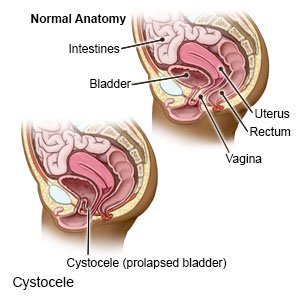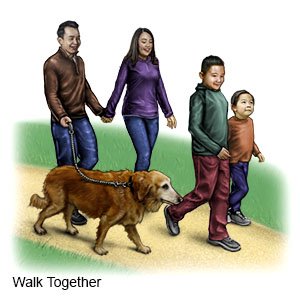Cystocele
Medically reviewed by Drugs.com. Last updated on Aug 4, 2025.
A cystocele is a condition that causes a part of your bladder to fall into your vagina because of weakened or stretched pelvic muscles. Your bladder may begin to slip through your vaginal opening.
 |
DISCHARGE INSTRUCTIONS:
Return to the emergency department if:
- You have bleeding from your vagina that is not your monthly period.
- You have a mass bulging out of your vagina that you cannot push back in.
- You have severe lower abdominal pain.
- You have a bad-smelling discharge coming from your vagina.
Related medications
Call your doctor or gynecologist if:
- You have a fever.
- You have chills or feel weak and achy.
- You have lower abdominal pain or back pain that does not go away.
- You cannot urinate.
- You have questions about your condition or care.
Manage or prevent a cystocele:
- Do Kegel exercises regularly. These exercises can help your pelvic floor muscles get stronger. Tighten the muscles of your pelvis (the muscles you use to stop urinating). Hold the muscles tight for 5 seconds, then relax for 5 seconds. Gradually work up to holding the muscles for 10 seconds. Do at least 3 sets of 10 repetitions a day.
- Do not strain. Do not lift heavy objects, stand for long periods of time, or strain to have a bowel movement. Prevent constipation by drinking plenty of liquids and eating foods high in fiber. Ask how much liquid to drink every day and which liquids are best for you. High-fiber foods, such as fruits, vegetables, and whole grains, soften bowel movements. This helps bowel movements pass more quickly through your colon. Slowly add fiber into your diet to avoid bloating, stomach pain, and gas.

- Maintain a healthy weight. Ask your healthcare provider what a healthy weight is for you. Your provider can help you create a weight loss plan, if needed. Your provider can also help you create a physical activity program. Physical activity, such as exercise, helps your bowels work better and decreases pressure inside your colon.

- Keep a record. Record the number of times you urinate each day. Describe the color and amount of your urine. Bring the record to your follow-up visits.
Follow up with your doctor or gynecologist as directed:
Write down your questions so you remember to ask them during your visits.
© Copyright Merative 2025 Information is for End User's use only and may not be sold, redistributed or otherwise used for commercial purposes.
The above information is an educational aid only. It is not intended as medical advice for individual conditions or treatments. Talk to your doctor, nurse or pharmacist before following any medical regimen to see if it is safe and effective for you.
Further information
Always consult your healthcare provider to ensure the information displayed on this page applies to your personal circumstances.
